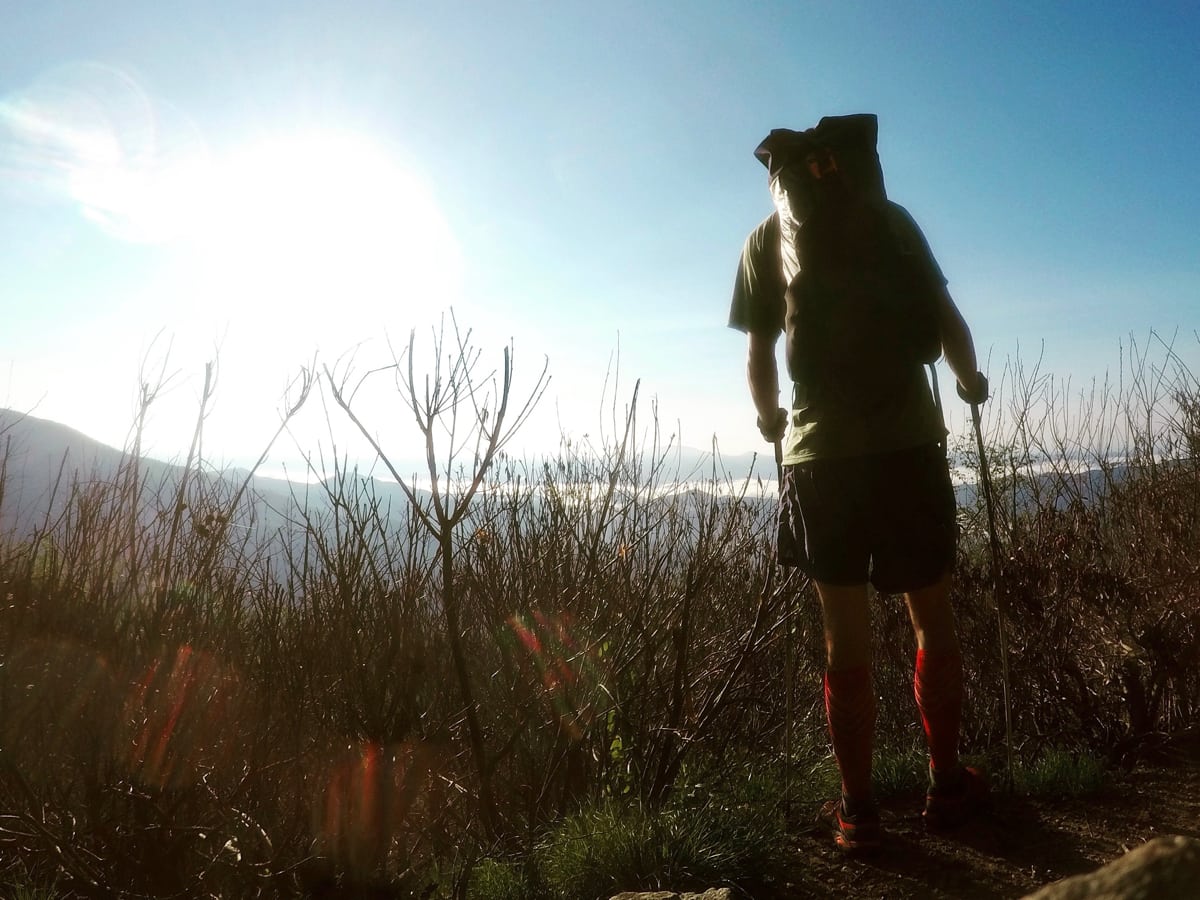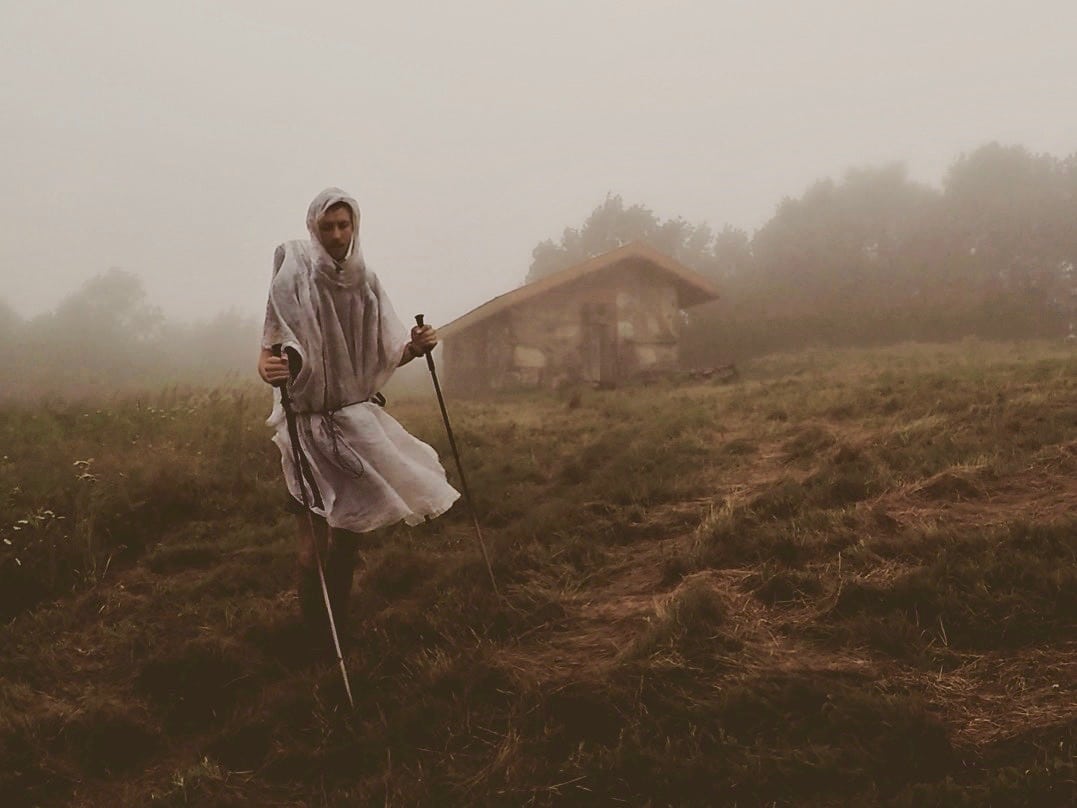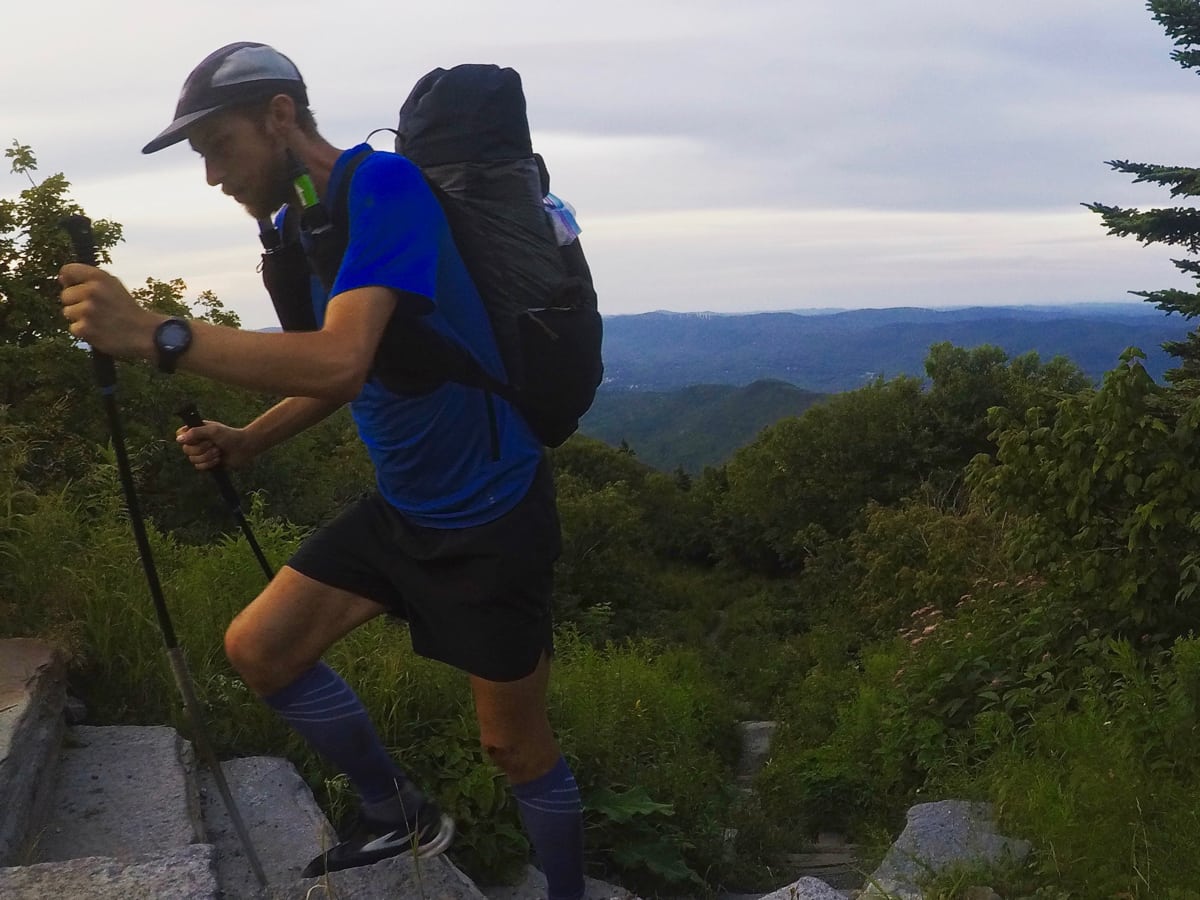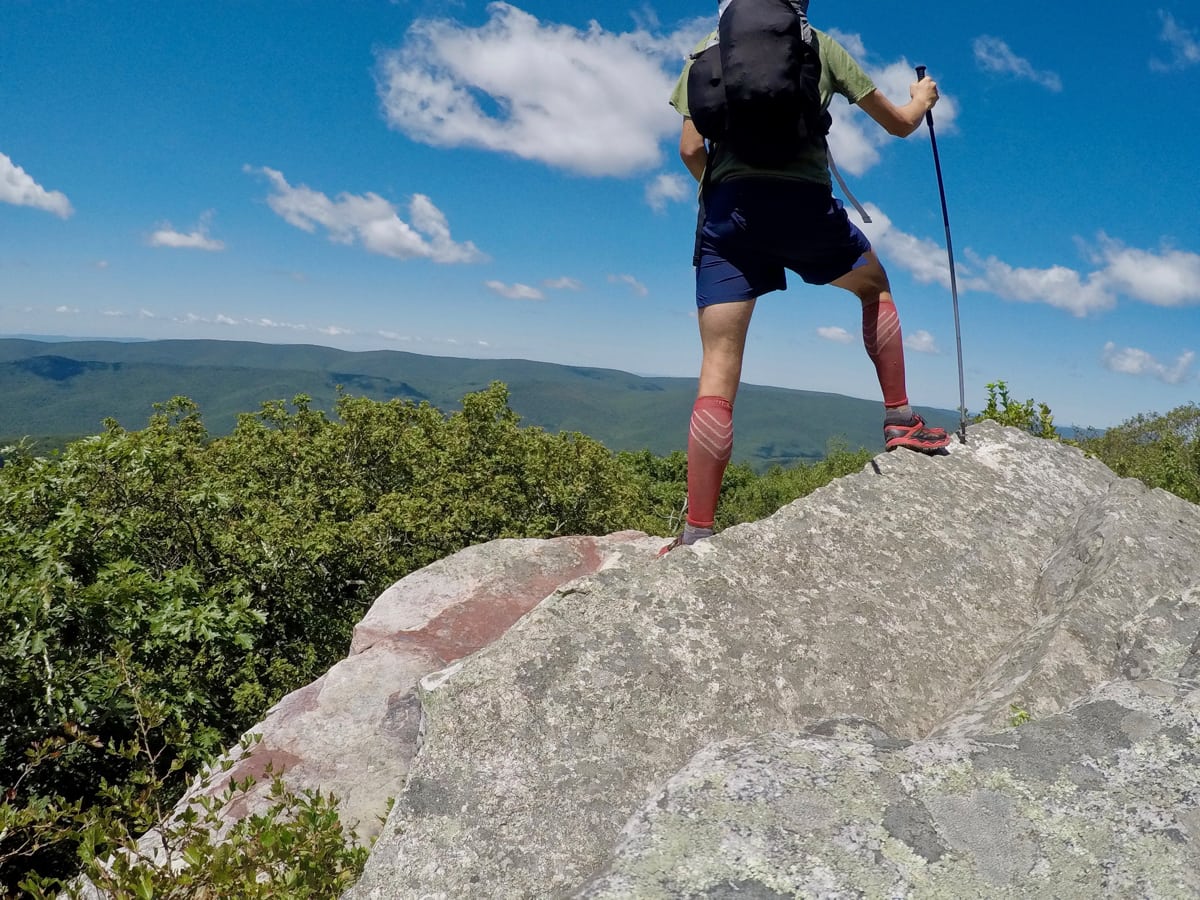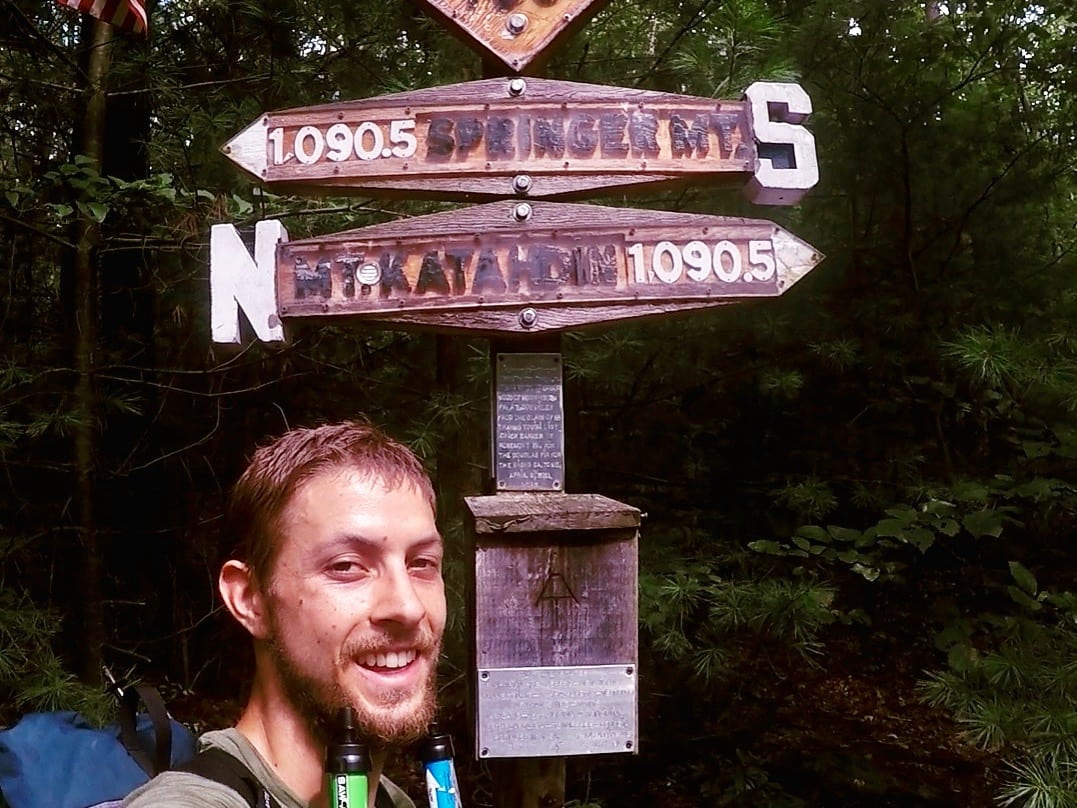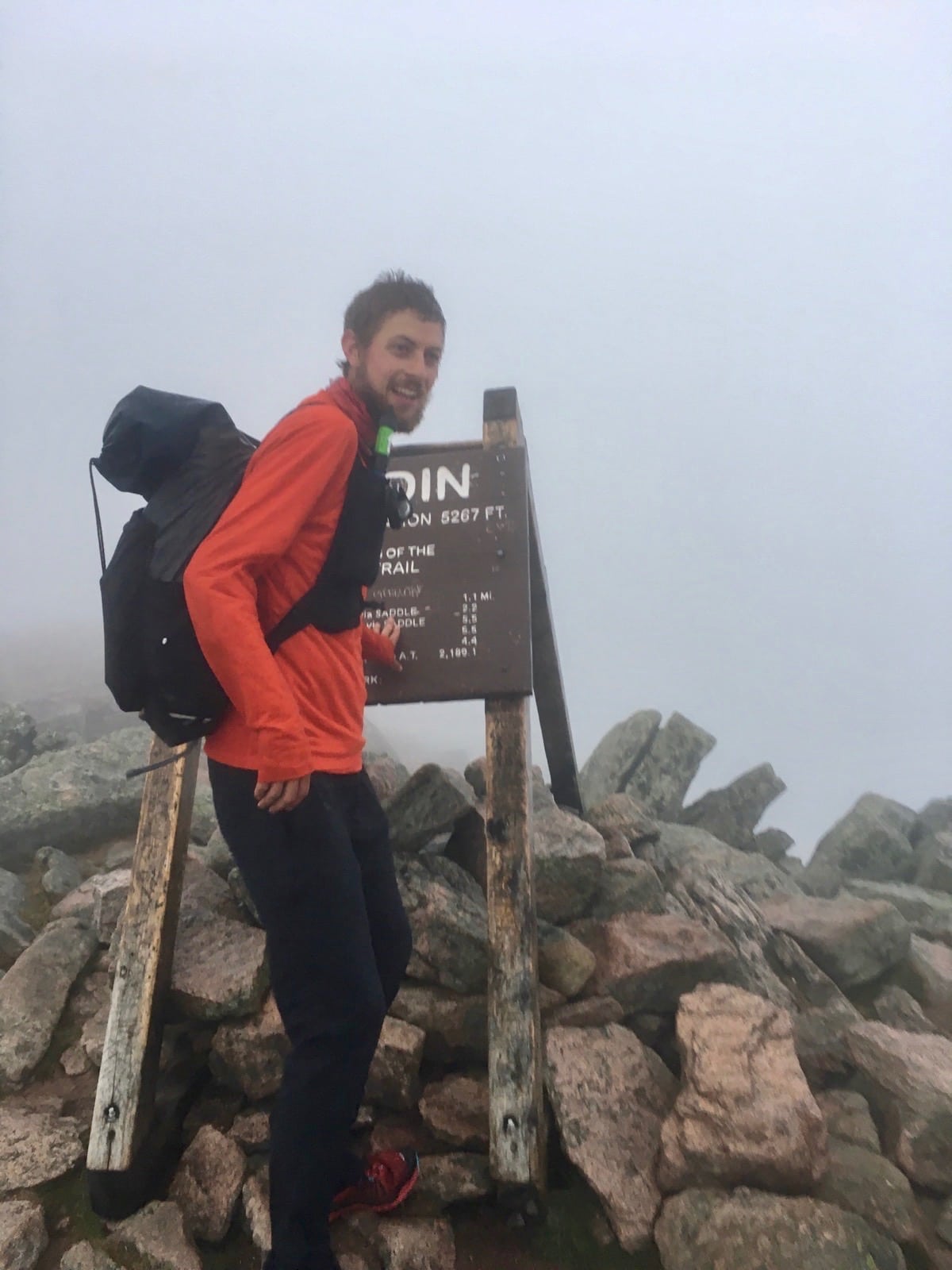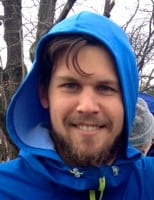It takes most people six months or more to complete the approximately 2,190-mile Appalachian Trail (AT). Joe ‘Stringbean’ McConaughy did it in a staggering 45 days, 12 hours, and 15 minutes. That’s an average of about 48 miles per day on the rugged AT, people! What makes the feat all the more remarkable is that McConaughy—or ‘Stringbean’, as he’s called on the trail—was self-supported the entire time, meaning he didn’t receive support from a crew along the trail, instead shipping all his food and supplies to predetermined points beforehand or buying food in stores he encountered along the way. The 26-year-old ‘Stringbean,’ who also holds the current supported Fastest Known Time (FKT) on the Pacific Crest Trail (PCT), started on July 17 in Georgia and ended atop Mount Katahdin in Maine on August 31. [Editor’s Note: Karel Sabbe did the PCT supported in the summer of 2016, finishing faster than Joe’s 2014 effort. However, Karel took several fire detours from the PCT proper.] As such, he demolished the previous self-supported FKT on the AT, held by Heather Anderson, by nearly nine days and bested the previous supported AT FKT, set by Karl Meltzer last year, by 10 hours and 23 minutes. The former Boston College track and cross-country runner took the time to fill us in on his epic accomplishment. Read on.
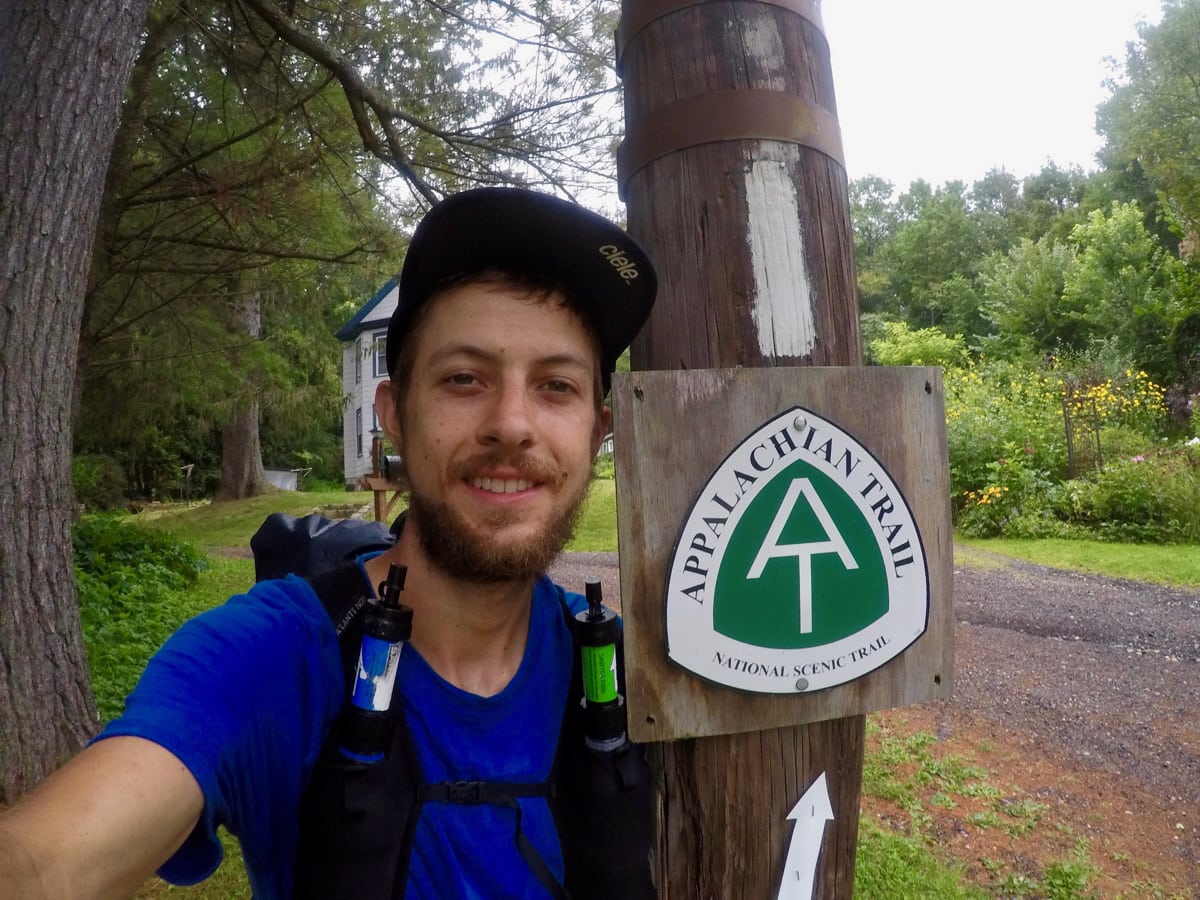
Joe ‘Stringbean’ McConaughy completed the Appalachian Trail in 45 days, 12 hours, and 15 minutes. All photos courtesy of Joe McConaughy.
iRunFar: You did it! You now have FKTs on both the PCT and the AT.
Joe McConaughy: [laughs] I did it, yeah, thanks. It still hasn’t sunk it. It’s been a whirlwind since it finished.
iRunFar: I’m sure. Even after an ultra race that takes one day, it usually takes a week to digest. I guess it might take 45 weeks before this sinks in for you.
McConaughy: [laughs] Yeah, it might take that long.
iRunFar: It’s been less than a week since you finished. I bet you’re still hungry all the time.
McConaughy: That’s all I’ve been doing, eating [laughs], yeah. I ate a fair amount already today so I’m done for a second. But soon I’ll have a frozen pizza and cookies and a bunch of stuff. You don’t really realize how non-human your portions are until you eat with other people. Then you’re like, “Oh, wow, that’s what a typical dinner would be.”
iRunFar: You set an FKT on the PCT in 2014. What motivated you to try for one on the AT this year?
McConaughy: I think the Appalachian Trail was the natural next step after the Pacific Crest Trail. It’s something I turned my thoughts to after the PCT but it took a while. I didn’t run for a long time after the PCT. It was maybe two or three months later and I started going out for runs but they were shorter and really slow and it didn’t feel good. I remember thinking, I remember this being more fun [laughs]. I was still pretty beat up. And I was in this beautiful place, Austria, for a year on a Fulbright to teach English, and I wasn’t motivated at all to run. But then I slowly started to feel better and I came back to Boston and started to run to and from work for leisure and exercise. Once I was feeling better I decided to try the Long Trail [in Vermont]. I made it around 90 miles in a day-and-a-half and my knee was swollen to the size of a watermelon and I didn’t finish. I did a trip to Europe a few weeks after that and I could barely fit my knee into my jeans and I was walking around cobblestone streets in Europe. It was bad [laughs].
iRunFar: It sounds like that it was the right move to call it quits.
McConaughy: [laughs] Yeah. So, I thought maybe I should try some races. I ran some shorter races around Boston, where I’m living, and even got back on the track a little bit. Then I decided to run an ultra and I had a good run at Stone Cat [50 Mile] last fall and then thought I’d try to qualify for the Western States 100, so I signed up for Gorge [Waterfall 100k] and Lake Sonoma [50 Mile] and figured Gorge would be easier to qualify. [Author’s Note: McConaughy’s back-to-back races were nicely documented in this short film.] But I didn’t qualify there so I ran Sonoma the next weekend [laughs] and by this point I realized I was actually going to get the time off to run the AT. So, in the end, the two races were good training for the trials of the AT. I didn’t end up qualifying for Western at either race but it’s one that I want to do at some point. One day at work—this was at the end of last year—my boss asked me about my professional development, what I saw myself doing in the future, and I casually sort of said that I wanted to thru-hike the AT [laughs]. My boss, Filippa, didn’t know what it was and I never thought I could get the time off but once I said it, it kind of became a reality and I started making plans for it, and she actually granted me the time off.
iRunFar: This is jumping ahead some, but you seem to really thrive at multi-week efforts rather than a long run in a single day like an ultra. Why do you think that is?
McConaughy: I think that’s true. I think a lot of it is my demeanor. There’s a video of the woman who set the fastest time on The Long Trail that really shows how bad it can be when you’re out there on the trail—the sort of meltdowns you can have. I’m able to keep it really even-keeled I think. One day, it was Day 38, I went 2,000 feet down this mountain and then realized that I had gone the wrong way, which is funny because the AT is actually really well marked. I had to turn around and go back up it and then continue through the White Mountains. By 3 p.m. that day I had only gone 11 trail miles and I only finished with 25 miles that day—my lowest-mileage day. So, I realize I went the wrong way and I have to retrace my steps up this mountain and it’s so defeating. I told myself, Here’s where you cry and throw all your stuff down and have a tantrum. But it never happened. I just thought about doing it and kept on hiking. And I think the multi-week stuff requires different skill sets than Western States or UTMB. To do well at those events you need to be a primed, top-tier athlete with very specific training. The psychological and logistical elements are different for long, thru-hikes. The skill sets from ultras don’t necessarily translate to long, multi-day events like the AT. I mean, it’s like an ultra on steroids [laughs].
iRunFar: Why did you decide to run the AT unsupported after running the PCT supported?
McConaughy: I think the unsupported route is more authentic and more accessible to people. Sponsors are great and people should have sponsors, and I totally respect those people, but I think going self-supported is more authentic to the trail community and what that’s all about, which is an experience in the wilderness. It’s less commercial.
iRunFar: And a self-supported attempt requires a lot of planning, too. What were the logistics like before attempting the AT?
McConaughy: Definitely. Just thinking about food takes a while. I wanted to keep my pack as light as possible so I researched to figure out the most nutrient- and calorically dense foods. My girlfriend, Katie, helped me out and we looked through different books and talked to people that had done the trail before. So, we figured that out and then I estimated how much food I would need on a given day, which was about 8,000 calories. I looked at the elevation charts and figured how far I would go on a given day, and so how much food I would need to drop at a given spot. Then you have to pack up boxes to ship out to different points on the trail. I was picking up a shipment every two to four days. I had to cover a certain number of miles to get to my next pick-up spot, so I would spend a lot of time every day looking at the maps and seeing how fast I was going, how fast I needed to go, how fast I could go to get to the next drop. And then some post offices were only open during a three-hour window, so you had to plan for that.
iRunFar: And that’s probably weeks and weeks of research and planning and that’s just the food.
McConaughy: [laughs] Right. Then I had to figure out gear. I wanted to make sure I had the lightest gear. I did research on the lightest bivy and sleeping bag and pad. I had a change of clothes at most of the drop points so I would run in basically one outfit for two or four days. I was dirty but it wasn’t too bad. I think the hardest part was water. I had to make sure I had enough water. Finding streams and keeping my bottle filled wasn’t always easy. I was pulling out the maps like every 20 or 30 minutes to see what was ahead and when I would have water. I would be really proud of myself if I could go two or three hours hiking without looking at the map [laughs]. But the toughest part was that I was using this filtration system in my water bottle that made it hard to chug out of. I could only really sip out of it. That maybe doesn’t sound that bad but I was out there thirsty and I would want to down water and I could only take small drinks.
iRunFar: So, you were basically dehydrated for 45 days—that sounds pretty bad [laughs].
McConaughy: [laughs] Basically. Whenever I got to a town I would buy a Gatorade and chug it, then I would fill it up in the bathroom and chug it again. I would get some food, refill the bottle, drink it one more time, then fill it and take it with me and down it later on when I got thirsty.
iRunFar: What all was in your pack and how much did it weigh?
McConaughy: I didn’t have first aid or any type of compression. That was an issue. But I got gauze wrap, which ended up being super useful. I had a Vaseline lip balm that was useful for chafing on my feet and crotch. That really helped. Anyway, it was about a 28-liter pack. It was custom made so I don’t know the exact size. Fully packed it had my bivy, pad, sleeping bag, food, water, a poncho tarp, a long sleeve shirt, thin athletic pants, a few others small things—money, cards, a GoPro, and a phone. The pack was anywhere from 25 to 28 pounds. I honestly don’t think it slowed me down that much, the weight, it more just made me injured [laughs].
iRunFar: What were some of the injuries?
McConaughy: It was a long list. Let’s see. You know, I keep telling people about injuries and then I remember more that I had [laughs]. So, blisters. Seven sprained ankles and all my right ankle, even though my left one is now the one that’s messed up. A swollen retinaculum on my left ankle. It’s really fat right now. Multiple micro tears, probably, in all the different muscles in my lower quads. I had eight wasp stings. Countless falls and from those a lot of cuts and bruises. The worst of those were my hips landing on rocks. Those were really sore and tough to move. I also had a strained tendon, I think, behind my knee. That was accompanied with a lot of swelling and pain on both knees. I had a strained hammy for a while on my right side. I had extreme chafing around my crotch. I had an open sore on my right foot that got infected. That was three-and-a-half weeks ago and it’s still around. I also had tendinitis on the top of my feet. What else did I have? I had an open sore on my back from the pack. I lost one toenail, believe it or not, only one. The bottoms of my feet are numb. Still [laughs]. I guess I had one or two small IT band issues but surprisingly they weren’t bad. Oh, and one groin strain.
iRunFar: Walk me through a day on the trail. What did that look like?
McConaughy: Sure. The alarm would go off at 4:45 a.m. I would get up and eat a couple hundred calories and start to pack things up. Then I would get in another 800 or 1,000 calories. I would get on the trail within about an hour. Then I’d have what I called my ‘morning miles’ [laughs]. It would be slow, slow running, and I’d cover maybe 2.5 miles an hour the first couple hours. I would ease into it. And I didn’t stop much. I kept energy bars near the front of my pack so that I could eat them as I went. I’d eat a bar every couple of hours throughout the morning. The pace would slowly start to pick up and it would go smoother. Then in the early afternoon around 2 or 3 p.m., I would try to eat a bigger meal of 1,000 calories or so. I’d keep pushing into the evening until I stopped to camp. Mostly you can camp on the side of the trail. I’d set up my bivy and put my pad down next to a tree and put my feet up and let them drain for 30 minutes while I ate two or three hundred calories. I’d take off my shoes and socks, and the running socks would sometimes take five minutes to get off [laughs]—that wasn’t fun. I’d eat another 1,000 calories or so and then be asleep by about 11 p.m. I’d wake up the next day and do it over again.
iRunFar: What a simple life.
McConaughy: [laughs] Simple but tough.
iRunFar: I’m curious what the journey was like for you mentally. For 45 days, you get up and cover 40, 50, or even 60 miles and you’re out there for 15 hours. How do you convince yourself that you can keep doing that day after day?
McConaughy: It’s really one step in the front of the other [laughs]. You know, I did Day 1 and I did 43 miles. I thought I would be able to do 50 miles—I was feeling good—but early on I sprained my ankle and I realized maybe I wouldn’t make 50 miles. But I did 43. Then, on Day 2, I was feeling good, feeling stronger, just starting off, not reaching into the tank too much, but I got really, really bad crotch chafing. I thought I would do 50 miles, but there was that and then a rain storm and I thought, Welp, I guess I’m doing 43 miles again—that’s what the trail allows. The next day I thought I might finally get to 50 miles. Things clicked more, I was able to get through the chafing, and I did a 52-mile day. At that point, I realized 50-mile days are doable.
A big mantra for me is that I can only run as far as the trail will allow and as my body dictates. When I was in the White Mountains doing 28-mile days, that kept me sane, realizing that I could only do what I could do on the day and pushing would only lead to injury. I had to do what I was able to and not do more. If I tried to do more, that’s when I got into trouble [with injuries]. It’s a weird balance where you have to stay below this imaginary threshold that you’re not really aware of but when you cross it, you know [laughs].
iRunFar: When achieving a goal becomes really tough, some people will give up. You don’t. Why is that?
McConaughy: I think self-discipline is probably the best word. Food is a good example of that. There were a few days when I was going slow. I planned to eat 8,000 calories per day for a two-day re-supply, but it turns into a three-day, or two-and-a-half-day re-supply. If I eat all the food as scheduled, I won’t have any for that extra day or half day. If I eat it all now, I won’t be as strong the next day. I have to be really self-disciplined in making sure that I have the fuel throughout the day. It’s really easy to want to eat everything and just go for it [laughs]. It’s really easy to always want to run and push and cover as much ground as you can as often as you can. But that will hurt you. At the same time, it’s easy to lay back and take it easy and do the minimum because you’re tired. But if you do that, there are days when you’re actually injured and need to push less but you won’t have the cushion to do that. So, it’s really about knowing how much you can and should push.
iRunFar: And that’s a lesson you learned from your experience on the PCT—how far you can push yourself.
McConaughy: Yeah. By the end of the PCT—and the trail is a lot different there, so it’s a little like apples and oranges to compare it to the AT—as long as I was eating, I would be able to cover 50 miles a day on reasonably challenging terrain, no matter what conditions were. That was my litmus test for the AT. I figured, No matter what the conditions are, I’ll be able to do close to 50 [miles]. Some days I’ll be farther, some days shorter, but I always had that really, really strong confidence in myself from the start. And especially seeing Meltzer average 48-mile days or so from the start. I knew that it’s physically possible so I knew that, considering my background, I felt I could match it. I had that validation from Meltzer, [Scott] Jurek, and Jennifer Pharr Davis.
iRunFar: Compared to the PCT, how much of the AT were you able to run?
McConaughy: I think I ran maybe 30 to 40% of the miles on the PCT, but I think on the AT, looking back, it was probably more like 45 to 50%—so more than the PCT but slower because of the terrain. I spent more time on my feet during the AT for sure, usually 15 hours or so each day.
iRunFar: Did you find the PCT or AT more challenging?
McConaughy: I don’t know. People say the AT is harder than the PCT but I think they cancel each other out with their challenges. The PCT is a lot easier to run. It’s graded and wider. But there’s longer spots for re-supply, there’s desert and the Sierra Nevada, which are super challenging. It gets really nasty in the Cascade Range, so you have to time that right. Then with the AT, it basically punches you in the face every day [laughs]. Roots and rocks and elevation—it’s tough.
iRunFar: I was going to ask about a single greatest challenge on the AT. I guess the whole thing is the challenge?
McConaughy: [laughs] Exactly. And I would have said that the AT was easier than the PCT until I ran into the White Mountains in New Hampshire and southern Maine. That changed my perspective, I’d say. It broke my confidence quite a lot.
iRunFar: Do you get excited when you realize the caliber of athletes you’ve been faster than on the AT?
McConaughy: Yeah, definitely. You know, there are some pretty impressive names [laughs]. I’ve read books that have these people in them [laughs]. So, it’s pretty cool to feel like you’re going up against titans of the sport. Karl had a lot of public support for what I was doing and that was really cool. I think that speaks to the nature of the type of thing I was trying to do. I hope that sentiment continues for people in the future. Before I hit the White Mountains and got destroyed, I thought I would take a few days, heal up a little bit, then go see if I could take the 100-mile record on the track [laughs]. Just for kicks to see where my fitness was at. Of course, now that I’m done, I will not be doing that [laughs]. But [running an FKT on the AT] puts all sorts of crazy ideas in your mind about what you’re capable of.
The last section of the trail is the first time I’ve run 100 miles continuously. So, I’m still figuring out what I’m capable of. Even with shorter ultras—50 milers and stuff—I feel like I’ve never… I’m a few tinkerings away from a good race. I think I have a lot of potential. I’m excited to get out there and keep trying at that.
iRunFar: Are you thinking about more ultras? It’s so soon since the AT that you probably don’t want to think about it.
McConaughy: [laughs] Yeah, I’ve thought about it. My girlfriend and I were looking into doing a race together. My brother lives in Tucson, Arizona. So, we’re considering Black Canyon [100k]. I’m thinking about a few other ultras, and also some of the long trails. My calendar isn’t set or anything right now. I want to get to Western States but I also want to run a 100 miler first to get some confidence about the distance. I’ll probably do a 100 miler, I guess. And Black Canyon and maybe some others. So, next year will be more focused on ultras to see where that takes me.
I told myself that the PCT was a once-in-a-lifetime trip. Then, I did the AT—I don’t even know how to define this one, but it’s also a once-in-a-lifetime trip [laughs]. When I was 23, straight out of college, I had to do a lot to make the PCT happen. But I had to sacrifice a lot more, and it was a lot harder for the people close to me, for the AT. Doing another big effort certainly interests me, but I’ll have to get my ducks in a row.
iRunFar: You’re going to end up with a lot of lifetimes, it sounds like.
McConaughy: [laughs] I guess so.
iRunFar: Do you see yourself as setting an example for other people through what you’re doing?
McConaughy: It’s kind of a new—it’s still being defined. It’s unique enough for anyone who does it that it will always continue to be defined. And it’s a long-distance hiking trail, so there’s the hiker community who uses it, primarily, and then the running community. I think it’s really important that the running and hiking communities are friendly with each other and it’s not something that is a battle between them—that would be a huge loss. Another thing I’ve thought about is that I’m the first person to really successfully run [rather than mostly hike] a long-distance trail in the U.S. like this self-supported. That’s cool to think about.
iRunFar: Tell me about that final stretch to the finish: 37 hours and about 110 miles continuously. That was a conscious effort to get under the previous record?
McConaughy: Yeah. I knew I could sleep overnight and [still get the record] but I wasn’t going to cut it to a few hours. I wasn’t going to risk it. It was definitely a conscious decision. I kept a pretty even pace all the way through. It wasn’t as fast as I’d like it to have been. The things that gave were my quads and the bottoms of my feet. I was still keeping a good pace, though. The nice thing was that after 72 miles of that section, it’s mostly flat and runnable, comparatively. I was able to get through the last night much faster than I thought I would. But I actually felt really good at the end of that. My legs were shot, though.
iRunFar: Can you summarize those last miles and it what it felt like to know you were going to accomplish your goal?
McConaughy: It was pretty funny [laughs]. It wasn’t what I expected. You know, I’m just finishing this last stretch that I’ve been going on for about 105 miles. I have a 4,500-foot climb to go. I start to think, I wonder when I’m going to cry, I can’t wait to see my girlfriend and my mom might be there. I’m going to be on top of a mountain finishing and before I thought I would and before sunset. What a way to end. All this hard work finally paid off. I start climbing and go maybe six- or seven-hundred feet and I feel a sting in my butt and a pull a wasp off and I had been stung. That’s the main climbing muscle. Then I start to feel it in my hamstring, right about my tendon, which is connected to my knee, which is now the thing that’s still swollen and inactive. So, I get stung on the worst spot [laughs]. I’m like, Ahhhhh, damn you! It can always get worse.
I knew that I’d have to get above treeline, and then there would be a few landmarks. I knew the climb was steep and that it flattens out near the top. So, I get above treeline and think I’ve climbed a few thousand feet. I get to a boulder section, it’s super challenging, and a 70-mile-per-hour wind starts. I thought, Wow, my girlfriend and her friend climbed through this to meet me. That’s awesome. I’m thinking I have about two miles to go. It’s legit climbing through this boulder section. I was using my scraggly arms. I can see the peak and it’s misty and foggy but I can see it. I keep climbing and climbing and my leg really hurts. I get close to the peak and start yelling. I don’t hear anything. I figure it’s the wind. But when I get to the top of that peak, I see that there’s another peak. Of course. I get to the top of the next one and I’m getting blown over and I get to a flat section. I realize there’s another whole section. Then there’s another steep climb and get up it and I’m in the fog and I realize I had just gotten to the long flat section. Once you get to the flat section, you supposedly still have 2.5 miles to go [laughs].
iRunFar: That’s brutal.
McConaughy: I start running and it’s really cool because the wind is at my back and I’m running uphill faster than I ever have on the trail because it’s so easy with the wind. It’s such a cool experience. Then I turn and the wind hits me and it starts to rain. It gets a little colder. Then, when I’m a quarter mile away, it starts hailing. I’m getting wrecked by hail and wind and I only have this light long sleeve. I finally get to the top but I’m so defeated at this point that I sit there for a few minutes and really didn’t have any emotions but just cried for three minutes. I tried to think about the whole trail and everything that happened. I was so exhausted and overwhelmed and stimulated. I don’t even know. I thought about everything and nothing at the same time. My thoughts were surprisingly vacant. Once I finished crying a little bit, I looked around—and I guess I had already hugged my girlfriend and her friend—and stared at them and was like, “Damn, this is done. I don’t know what to do right now.” Then I started to get cold and it was already 6:50 p.m. I was like, “Let’s just get off this damn mountain!” I had this flowery image in my mind of the finish on top of a mountain and of all the people that had helped me, and all the incredible scenery, and all that I had seen along the way. But I guess other things were more pressing.
iRunFar: I’d say in the end you kept doing what you had been doing for 45 days—you kept moving.
McConaughy: Exactly. I think it was really representative of the trail and my whole journey.
iRunFar: Here’s to the next one. Congratulations, Joe.
